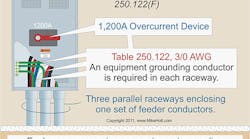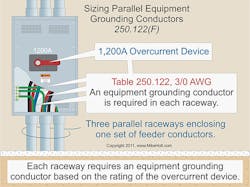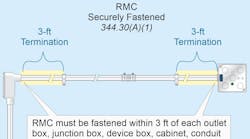All questions and answers are based on the 2011 NEC.
Q. If circuit conductors are installed in parallel in separate raceways, is an equipment grounding conductor required in each raceway? If so, how do I size it?
A. If circuit conductors are installed in parallel in separate raceways as permitted by 310.10(H), an equipment grounding conductor must be installed for each parallel conductor set [250.122(F)]. Where conductors are installed in parallel in the same raceway or cable tray, a single equipment grounding conductor is permitted.
Each equipment grounding conductor must be sized in accordance with Table 250.122, based on the rating of the circuit overcurrent device. However, it’s not required to be larger than the circuit conductors [250.122(A)].
Let’s work a sample problem.
A 1,200A disconnect supplies feeder conductors paralleled in three PVC raceways. What size copper equipment grounding conductor is required for the feeder circuit? (Figure)
As per Table 250.122, a 3/0 AWG in each raceway would work based on the 1,200A feeder protection device [250.122(F)].
Q. What are the rules that permit more than one service to a building or structure?
A. A building/structure can only be served by one service drop or service lateral, except as permitted by (A) through (D) [230.2]. Service laterals 1/0 AWG and larger run to the same location and connected together at their supply end, but not connected together at their load end, are considered to be a single service. Additional services are permitted for the following special conditions [230.2(A)]:
1) Fire pumps
2) Emergency systems
3) Legally required standby systems (Note: A separate service for emergency and legally required systems is permitted only when approved by the authority having jurisdiction [700.12(D) and 701.11(D)]).
4) Optional standby power
5) Parallel power production systems
6) Systems designed for connection to multiple sources of supply for the purpose of enhanced reliability. Note: To minimize the possibility of accidental interruption, the disconnecting means for the fire pump, emergency system, or standby power system must be located remotely away from the normal power disconnect [230.72(B)].
By special permission, additional services are permitted for the following special occupancies [230.2(B)]:
1) Multiple-occupancy buildings where there’s no available space for supply equipment accessible to all occupants, or
2) A building or other structure so large that two or more supplies are necessary.
Additional services are permitted for the following special capacity requirements [230.2(C)]:
1) If the capacity requirements exceed 2,000A, or
2) If the load requirements of a single-phase installation exceed the utility’s capacity, or
3) By special permission. Note: Special permission is defined in Art. 100 as: “the written consent of the authority having jurisdiction.”
Additional services are permitted for different voltages, frequencies, or phases, or for different uses, such as for different electricity rate schedules [230.2(D)].
If a building/structure is supplied by more than one service, or a combination of feeders and services, a permanent plaque or directory must be installed at each service and feeder disconnect location to denote all other services and feeders supplying that building/structure, and the area served by each [230.2(E)].





